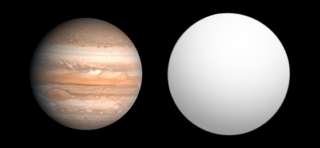Related Research Articles

CoRoT was a space telescope mission which operated from 2006 to 2013. The mission's two objectives were to search for extrasolar planets with short orbital periods, particularly those of large terrestrial size, and to perform asteroseismology by measuring solar-like oscillations in stars. The mission was led by the French Space Agency (CNES) in conjunction with the European Space Agency (ESA) and other international partners.

A super-Jupiter is a gas giant exoplanet that is more massive than the planet Jupiter. For example, companions at the planet–brown dwarf borderline have been called super-Jupiters, such as around the star Kappa Andromedae.

Chthonian planets are a hypothetical class of celestial objects resulting from the stripping away of a gas giant's hydrogen and helium atmosphere and outer layers, which is called hydrodynamic escape. Such atmospheric stripping is a likely result of proximity to a star. The remaining rocky or metallic core would resemble a terrestrial planet in many respects.

Hot Jupiters are a class of gas giant exoplanets that are inferred to be physically similar to Jupiter but that have very short orbital periods. The close proximity to their stars and high surface-atmosphere temperatures resulted in their informal name "hot Jupiters".

CoRoT-2b is the second extrasolar planet to be detected by the French-led CoRoT mission, and orbits the star CoRoT-2 at a distance of 700 light years from Earth towards the constellation Aquila. Its discovery was announced on 20 December 2007. After its discovery via the transit method, its mass was confirmed via the radial velocity method.
This page describes exoplanet orbital and physical parameters.

CoRoT-7b is an exoplanet orbiting the star CoRoT-7 in the constellation of Monoceros, 489 light-years from Earth. It was first detected photometrically by the French-led CoRoT mission and reported in February 2009. Until the announcement of Kepler-10b in January 2011, it was the smallest exoplanet to have its diameter measured, at 1.58 times that of the Earth and the first potential extrasolar terrestrial planet to be found. The exoplanet has a very short orbital period, revolving around its host star in about 20 hours.

TRAPPIST-1f, also designated as 2MASS J23062928-0502285 f, is an exoplanet, likely rocky, orbiting within the habitable zone around the ultracool dwarf star TRAPPIST-1, located 40.7 light-years away from Earth in the constellation of Aquarius. The exoplanet was found by using the transit method, in which the dimming effect that a planet causes as it crosses in front of its star is measured.

TRAPPIST-1g, also designated as 2MASS J23062928-0502285 g and K2-112 g, is an exoplanet orbiting around the ultra-cool dwarf star TRAPPIST-1, located 40.7 light-years away from Earth in the constellation Aquarius. It was one of four new exoplanets to be discovered orbiting the star in 2017 using observations from the Spitzer Space Telescope. The exoplanet is within the optimistic habitable zone of its host star. It was found by using the transit method, in which the dimming effect that a planet causes as it crosses in front of its star is measured.
K2-141b is a massive rocky exoplanet orbiting extremely close to an orange main-sequence star K2-141. The planet was first discovered by the Kepler space telescope during its K2 “Second Light” mission and later observed by the HARPS-N spectrograph. It is classified as an Ultra-short Period (USP) and is confirmed to be terrestrial in nature. Its high density implies a massive iron core taking up between 30% and 50% of the planet's total mass.
CoRoT-21b is a transiting exoplanet reportedly found by the CoRoT space telescope in 2011. Planetary parameters were published in 2012.

CoRoT-14b is a transiting Hot Jupiter exoplanet found by the CoRoT space telescope in 2010.
CoRoT-18b is a transiting Hot Jupiter exoplanet found by the CoRoT space telescope in 2011.
K2-66b is a confirmed mega-Earth orbiting the subgiant K2-66, about 520 parsecs (1,700 ly) from Earth in the direction of Aquarius. It is an extremely hot and dense planet heavier than Neptune, but with only about half its radius.
CoRoT-20 is a star, which is located in the constellation Monoceros at a distance of about 4011 light years from us. The star is orbited by at least two planets.
CoRoT-8 is a star in the constellation Aquila at a distance of about 1239 light-years from us. At least one planet revolves around the star.
References
- ↑ "Notes on CoRoT-20 b". Extrasolar Planets Encyclopaedia . Retrieved February 25, 2019.
- ↑ "COROT-20 Planets in the system" . Retrieved February 25, 2019.
- ↑ Deleuil, M.; Bonomo, A. S.; Ferraz-Mello, S.; Erikson, A.; Bouchy, F.; Havel, M.; Aigrain, S.; Almenara, J. -M.; Alonso, R.; Auvergne, M.; Baglin, A.; Barge, P.; Bordé, P.; Bruntt, H.; Cabrera, J.; Carpano, S.; Cavarroc, C.; Csizmadia, Sz.; Damiani, C.; Deeg, H. J.; Dvorak, R.; Fridlund, M.; Hébrard, G.; Gandolfi, D.; Gillon, M.; Guenther, E.; Guillot, T.; Hatzes, A.; Jorda, L.; et al. (2011). "Transiting exoplanets from the CoRoT space mission⋆ XX. CoRoT-20b: A very high density, high eccentricity transiting giant planet". arXiv: 1109.3203 . doi:10.1051/0004-6361/201117681. S2CID 118339296.
{{cite journal}}: Cite journal requires|journal=(help)